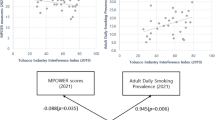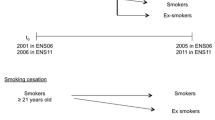Abstract
Objectives
This study provides information about the prevalence of tobacco prevention (TP) and the stages of change with respect to the introduction of TP among companies in the Canton of Zurich (n = 1,648). It explores the factors that predict restrictiveness of smoking policies, number of individual support measures, interest in services to promote TP, and the relationship between TP and health outcomes.
Methods
Data were gathered by means of a written questionnaire and analysed using ordinal regression models.
Results
Whereas many companies maintain smoke-free policies, only few provide cessation-courses. Health and welfare organisations have strictest, and building and hospitality companies have least strict policies. Company size predicts number of individual support measures but not policy restrictiveness. Both measures are predicted by personal concern of the representative. Interest in services is predicted by tobacco-related problems and medium stages of change. Finally, stricter policies are associated with lower proportion of smokers and less tobacco-related problems.
Conclusions
Health professionals should support less advanced companies in their endeavour to implement TP. The findings provide a baseline to evaluate the implementation of the forthcoming smoke-free legislation.


Similar content being viewed by others
References
Albertsen K, Borg V, Oldenburg B (2006) A systematic review of the impact of work environment on smoking cessation, relapse and amount smoked. Prev Med 43:291–305
Ashley MJ, Eakin J, Bull S, Pederson L (1997) Smoking control in the workplace: Is workplace size related to restriction and programs? J Occup Environ Med 39:866–873
Barone-Adesi F, Vizzini L, Merletti F, Richiardi L (2006) Short-term effects of Italian smoking regulation on rates of hospital admission for acute myocardial infarction. Eur Heart J 27:2468–2472
Bauer G, Jenny G (2007) Development, implementation and dissemination of occupational health management (OHM): putting salutogenesis into practice. In: McIntyre S, Houdmondt J (eds) Occupational health psychology: European perspectives on research, education and practice, vol 2. ISMAI, Castelo da Maia, pp 219–250
Bauer G, Schmid M, Zellweger U, Krueger H (2002) Betriebliches Gesundheitsmanagement 2001 - Entwicklungsstand in Schweizer Dienstleistungsunternehmen [Worksite health promotion 2001—Stage of development in Swiss service businesses]. Institut für Sozial- und Präventivmedizin der Universität Zürich/Institut für Hygiene und Arbeitsphysiologie ETH Zürich, Zürich
Biener L, Glanz K, McLerran D, Sorensen G, Thompson B, Basen-Engquist K, Linnan L, Varnes J (1999) Impact of the working well trial on the worksite smoking and nutrition environment. Health Educ Behav 26:478–494
Brownson RC, Hopkins DP, Wakefield MA (2002) Effects of smoking restrictions in the workplace. Annu Rev Public Health 23:333–348
Buchmann H, Müller R (2001) Alkohol- und Tabakprävention in Schweizer Unternehmen [Alcohol and tobacco prevention in Swiss companies]. SFA/ISPA, Lausanne
Bush R, Wooden M (1995) Smoking and absence from work: Australian evidence. Soc Sci Med 41:437–446
Cooke M (2000) The dissemination of a smoking cessation program: Predictors of program awareness, adoption and maintenance. Health Promot Int 15:113–124
Emmons KM, Biener L (1993) The impact of organizational characteristics on smoking policy restrictions in midwestern hospitals. Am J Health Promot 8:43–49
Emmons KM, Thompson B, McLerran D, Sorensen G, Linnan L, Basen-Engquist K, Biener L (2000) The relationship between organizational characteristics and the adoption of workplace smoking policies. Health Educ Behav 27:483–501
Evans WN, Farrelly MC, Montgomery E (1999) Do workplace smoking bans reduce smoking? Am Econ Rev 89:728–747
Fichtenberg CM, Glantz SA (2002) Effect of smoke-free workplaces on smoking behaviour: systematic review. Br Med J 325:188–191
Fielding JE (1990) Worksite health promotion survey: smoking control activities. Prev Med 19:402–413
Frankish JC, Johnson JL, Ratner PA, Lovato CY (1997) Relationship of organizational characteristics of Canadian workplaces to anti-smoking initiatives. Prev Med 26:248–256
Gerlach KK, Shopland DR, Hartman AM, Gibson JT, Pechacek TF (1997) Workplace smoking policies in the United States: Results from a national survey of more than 100, 000 workers. Tob Control 6:199–206
Glasgow RE, Sorensen G, Corbett K (1992) Worksite smoking control activities: prevalence and related worksite characteristics from the COMMIT Study, 1990. Prev Med 21:688–700
Glasgow RE, Sorensen G, Giffen C, Shipley RH, Corbett K, Lynn W (1996) Promoting worksite smoking control policies and actions: the community intervention trial for smoking cessation (COMMIT) experience. Prev Med 25:186–194
Halpern MT, Shikiar R, Rentz AM, Khan ZM (2001) Impact of smoking status on workplace absenteeism and productivity. Tob Control 10:233–238
Hammond SK, Sorensen G, Youngstrom R, Ockene JK (1995) Occupational exposure to environmental tobacco smoke. JAMA 274:956–960
Heloma A, Jaakkola M (2003) Four-year follow-up of smoke exposure, attitudes and smoking behaviour following enactment of Finland’s national smoke-free work-place law. Addiction 98:1111–1117
Herbst K, Kraus L, Scherer K (1996) Repräsentativerhebung zum Gebrauch psychoaktiver Substanzen bei Erwachsenen in Deutschland: Schriftliche Erhebung 1995 [Representative poll among adults in Germany on the use of psychoactive substances: Written survey in 1995]. Bundesministerium für Gesundheit/IFT, München
Hu SC, Huang SY, Li D, Wen CP, Tsai SP (2005) Workplace smoking policies in Taiwan and their association with employees’ smoking behaviours. Eur J Public Health 15:270–275
Huisman M, Kunst AE, Mackenbach JP (2005) Inequalities in the prevalence of smoking in the European Union: Comparing education and income. Prev Med 40:756–764
Keller R, Radtke T, Krebs H, Hornung R (2009) Der Tabakkonsum der Schweizer Wohnbevölkerung in den Jahren 2001 bis 2008. Tabakmonitoring – Schweizerische Umfrage zum Tabakkonsum [Tobacco consumption in the Swiss resident population between 2001 and 2008. Tobacco monitoring - Swiss Survey of Tobacco Consumption]. Institut der Universität Zürich, Sozial- und Gesundheitspsychologie, Zürich
Levy DT, Chaloupka F, Gitchell J (2004) The effects of tobacco control policies on smoking rates: a tobacco control scorecard. J Public Health Manag Pract 10:338–353
Linnan L, Emmons KM, Abrams DB (2002) Beauty and the beast: results of the Rhode Island smokefree shop initiative. Am J Public Health 92:27–28
Marcus BH, Emmons KM, Abrams DB, Marshall RJ, Kane M, Novotny TE, Etzel RA (1992) Restrictive workplace smoking policies: Impact on nonsmokers’ tobacco exposure. J Public Health Policy 13:42–51
McMahan S, Wells M, Stokols D, Phillips K, Clitheroe HC (2001) Assessing health promotion programming in small businesses. Am J Health Stud 17:120–130
McMahon A, Kelleher C, Helly G, Duffy E (2002) Evaluation of a workplace carciovascular health promotion programme in the Republic of Ireland. Health Promot Int 17:297–308
Menzies D, Nair A, Williamson PA, Schembri S, Al-Khairalla MZH, Barnes M, Fardon TC, McFarlane L, Magee GJ, Lipworth BJ (2006) Respiratory symptoms, pulmonary function, and markers of inflammation among bar workers before and after a legislative ban on smoking in public places. JAMA 296:1742–1748
Prochaska JM (2000) A transtheoretical model for assessing organizational change: A study of family service agencies’ movement to time-limited therapy. Fam Soc J Contemp H 81:76–84
Radtke T, Krebs H, Keller R, Hornung R (2007) Passivrauchen in der Schweizer Bevölkerung 2006 [Second-hand smoking in the Swiss population 2006]. Psychologisches Institut, Universität Zürich, Zürich
Repace JL, Hyde JN, Brugge D (2006) Air pollution in Boston bars before and after a smoking ban. BMC Public Health 6: np
Rogers EM (2003) Diffusion of innovations, 5th edn. Free Press, New York
Sorensen G, Rigotti N, Rosen A, Pinney J, Prible R (1991) Effects of a worksite nonsmoking policy: evidence for increased cessation. Am J Public Health 81:202–204
Sorensen G, Glasgow RE, Topor M, Corbett K (1997) Worksite characteristics and changes in worksite tobacco-control initiatives: results from the COMMIT study. J Occup Environ Med 39:520–526
U.S. Department of Health and Human Services (1993) 1992 National survey of worksite health promotion activities: summary. Am J Health Promot 7:452–464
U.S. Department of Health and Human Services (2006) The health consequences of involuntary exposure to tobacco smoke: a report of the surgeon general. U.S. Department of Health and Human Services, Centers for Disease Control and Prevention, Coordinating Center for Health Promotion, National Center for Chronic Disease Prevention and Health Promotion, Office on Smoking and Health, Atlanta, GA
Acknowledgments
The authors would like to thank the Tobacco Prevention Fund (Swiss Federal Office of Public Health) for funding this study. We also thank the following persons for their support: Julia Braun (statistical analyses), Florine Gafner (questionnaire development and scanning), Greg Jenny and Silvia Deplazes (proposal writing), and Anita Emch and Katharina Lehmann (data collection and project cooperation).
Author information
Authors and Affiliations
Corresponding author
Rights and permissions
About this article
Cite this article
Friedrich, V., Brügger, A. & Bauer, G. Worksite tobacco prevention in the Canton of Zurich: stages of change, predictors, and outcomes. Int J Public Health 54, 427–438 (2009). https://doi.org/10.1007/s00038-009-0084-0
Received:
Revised:
Accepted:
Published:
Issue Date:
DOI: https://doi.org/10.1007/s00038-009-0084-0




